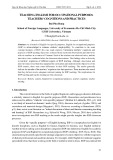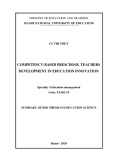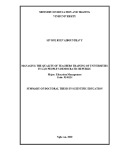
P-ISSN 1859-3585 E-ISSN 2615-9619 https://jst-haui.vn LANGUAGE - CULTURE
Vol. 61 - No. 2 (Feb 2025) HaUI Journal of Science and Technology
115
TEACHER
ASSESSMENT
LITERACY
IN
TASK-BASED
LANGUAGE
TEACHING
(TBLT)
AT
UNIVERSITIES
IN
VIETNAM
NĂNG LỰC ĐÁNH GIÁ CỦA GIẢNG VIÊN TRONG GIẢNG DẠY NGÔN NGỮ
DỰA TRÊN NHIỆM VỤ TẠI CÁC TRƯỜNG ĐẠI HỌC Ở VIỆT NAM
Nguyen Quynh Anh1,*
DOI: http://doi.org/10.57001/huih5804.2025.044
1. INTRODUCTION
The increasing need for
English in real-life situations
and specific professional
contexts has driven the
adoption of more
communicative teaching
methods. Recognizing that
language education goes
beyond simply teaching
grammar and vocabulary, many
developing Asian countries
have transitioned from
traditional methods like
grammar-translation and
Audiolingual approaches to
communicative language
teaching, particularly Task-
Based Language Teaching
(TBLT) [1]. Particularly, TBLT is
described as a more
comprehensive approach to
communicative teaching,
where tasks form the
foundation of the entire
curriculum. Developing a task-
based curriculum involves
selecting tasks relevant to
students’ needs, organizing
them sequentially, and
determining the specific
methodological procedures for
each task [2]. This student-
centered approach requires
ABSTRACT
Task-
based language teaching (TBLT) has gained widespread recognition as a leading teaching approach
globally, prompting extensive research into various aspects of this methodology. Despite this, little research has
been done to evaluate assessment in TBLT
principles. To address this gap, this study seeks to examine the
application of Task-
Based Language Assessment (TBLA) in several Vietnamese universities, where TBLT is
implemented as the main teaching methodology. A questionnaire was used to collect quantitative
data from 52
teachers at these institutions, where TBLT serves as the primary teaching methodology. The findings show that
teachers have a basic awareness of several key aspects of TBLA, including the use of authentic tasks, criterion-
referenced assessment
, and direct assessment methods. However, there are still gaps in their understanding and
practices, particularly concerning the integration of language skills and the creation of reliable scoring criteria.
This study highlights the need for further teacher training in TBLA to address the mismatch between teaching
and testing practices, ensuring effective implementation and assessment in TBLT-focused curricula.
Keywords: Task-based language teaching (TBLT), task-
based language assessment (TBLA), testing
practice, teacher
assessment literacy, teacher training.
TÓM TẮT
Phương pháp giảng dạy ngôn ngữ theo nhiệm vụ (TBLT) đang ngày càng phổ biến trên toàn thế giới, vớ
i
nhiều nghiên cứu tập trung vào các khía cạnh khác nhau của phương pháp này. Tuy nhiên, trong lĩnh vực kiể
m
tra, đánh giá, có rất ít nghiên cứu đi sâu vào việc áp dụng các nguyên tắc đánh giá theo nhiệm vụ
(TBLA) vào
thực tiễn giảng dạy. Nghiên cứu này đánh giá việc áp dụng TBLA trong giảng dạy tại các trường đại học ở Việ
t
Nam, nơi TBLT được sử dụng làm phương pháp chính. Kết quả từ bảng khảo sát 52 giáo viên cho thấy họ
có
hiểu biết cơ bản về TBLA, đặc biệt trong việc áp dụng các nhiệm vụ thực tế và đánh giá dựa trên tiêu chí cụ
thể. Tuy nhiên, vẫn còn những hạn chế trong việc tích hợp các kỹ năng ngôn ngữ và thiết lập mộ
t tiêu chí
chấm điểm đáng tin cậy. Nghiên cứu cũng chỉ ra sự cần thiết trong việc đào tạo giáo viên về TBLA để đảm bả
o
việc thực hiện kiểm tra, đánh giá một cách hiệu quả.
Từ khóa: Giảng dạy ngôn ngữ theo nhiệm vụ, đánh giá ngôn ngữ theo nhiệm vụ, thực tiễn kiể
m tra, đánh
giá, đào t
ạo giáo viên.
1School of Languages and Tourism, Hanoi University of Industry, Vietnam
*Email: anhnq@haui.edu.vn
Received: 10/11/2024
Revised: 13/01/2025
Accepted: 27/02/2025



























